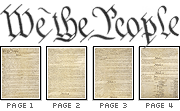U.S. Constitution Primer

Balancing the rights of the federal government, the states, and individuals
by Shmuel Ross
We the people of the United States, in order to form a more perfect Union, establish justice, insure domestic tranquility, provide for the common defence, promote the general welfare, and secure the blessings of liberty to ourselves and our posterity, do ordain and establish this Constitution for the United States of America.
So begins the Constitution of the United States, written in 1787 to replace the nation's first guiding document, the 1777 Articles of Confederation. The Federalists had been clamoring for a stronger central government, and the Constitution was designed to provide this while balancing it with the rights of individual states—both large and small—and individual citizens. To meet all these requirements, it set up a bicameral legislature and independent judicial and executive branches. Much of this had been proposed by James Madison in his Virginia Plan earlier that year.
The Constitution was signed on September 17—now known as Constitution Day and Citizenship Day—and was submitted to the states for ratification. Over the course of the following three years, it was ratified by all thirteen states then existing. The first ten amendments—the Bill of Rights—were added by the first Congress and ratified in 1791, to more explicitly safeguard individual rights.
The Constitution of the United States of America
- Introduction | Encyclopedia Article
- The Preamble | Commentary
- The Articles: I II III IV V VI VII | Commentary
- The Amendments | Commentary
- Signers of the Constitution
- Glossary of Constitutional Terms
Writing and Ratification of the Constitution
- The Continental Congress
- The Constitutional Convention
- The Federalist Papers | About the Federalists
- The Anti-Federalists
- Anti-Federalist Writings
- Ratification by the States
Precursors to the Constitution
- The Magna Carta (1215) | Encyclopedia Article
- The Mayflower Compact (Nov. 21, 1620) | Encyclopedia Article
- The Declaration of Independence (July 4, 1776) | Encyclopedia Article
- The Articles of Confederation (Adopted Nov 15, 1777) | Encyclopedia Article
- The Virginia Plan (May 29, 1787)
Celebrating the Constitution
Back to the top
Ratification by the States
The draft (originally a preamble and seven Articles) was submitted to all thirteen states and was to become effective when ratified by nine states. It went into effect on the first Wednesday in March 1789, having been ratified by New Hampshire, the ninth state to approve, on June 21, 1788. The states ratified the Constitution in the following order:
Back to the top
Signers of the United States Constitution | ||
| President and deputy from Virginia George Washington Delaware George Read Gunning Bedford, Jr. John Dickinson Richard Bassett Jacob Broom Maryland James McHenry Daniel of St. Thomas Jenifer Daniel Carroll Virginia John Blair James Madison Jr. North Carolina William Blount Richard Dobbs Spaight Hugh Williamson | South Carolina John Rutledge Charles Cotesworth Pinckney Charles Pinckney Pierce Butler Georgia William Few Abraham Baldwin New Hampshire John Langdon Nicholas Gilman Massachusetts Nathaniel Gorham Rufus King Connecticut William Samuel Johnson Roger Sherman | New York Alexander Hamilton New Jersey William Livingston David Brearley William Paterson Jonathan Dayton Pennsylvania Benjamin Franklin Thomas Mifflin Robert Morris George Clymer Thomas Fitzsimons Jared Ingersoll James Wilson Gouverneur Morris |

